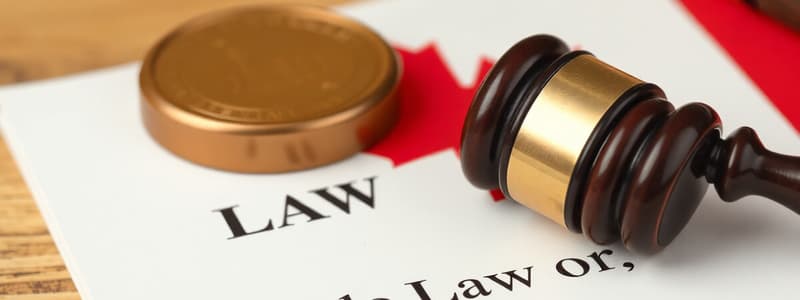Podcast
Questions and Answers
In a scenario where a company knowingly releases a harmful product, causing significant public health issues, which type of damages would be most applicable in a lawsuit against them?
In a scenario where a company knowingly releases a harmful product, causing significant public health issues, which type of damages would be most applicable in a lawsuit against them?
- Compensatory Damages, to cover the medical expenses of those affected.
- Punitive Damages, to punish the company for their egregious misconduct and deter similar actions. (correct)
- Injunctions, to halt the further distribution of the harmful product.
- Nominal Damages, to acknowledge the harm caused even if actual losses are minimal.
If the federal government enacts a law regulating education standards, which legal doctrine could be invoked to challenge the law's validity?
If the federal government enacts a law regulating education standards, which legal doctrine could be invoked to challenge the law's validity?
- Res Ipsa Loquitur, indicating the obvious negligence of the federal government.
- Stare Decisis, arguing that past decisions support provincial jurisdiction.
- Consensus ad Idem, claiming a lack of agreement between the federal and provincial governments.
- Ultra Vires, asserting that education falls under provincial powers according to Section 92. (correct)
A contract includes a clause that states the agreement will be void should a specific, improbable natural disaster occur. Which Latin term best describes this clause?
A contract includes a clause that states the agreement will be void should a specific, improbable natural disaster occur. Which Latin term best describes this clause?
- Force Majeure, excusing performance due to an unforeseeable event. (correct)
- Non Est Factum, claiming the signatory was unaware of the clause.
- Restitutio in Integrum, restoring the parties to their original positions.
- Consensus ad idem, ensuring both parties agree to the terms.
In a personal injury case, the plaintiff's lawyer argues that the accident could not have happened unless the defendant was negligent, even without direct evidence of negligence. Which legal principle is the lawyer applying?
In a personal injury case, the plaintiff's lawyer argues that the accident could not have happened unless the defendant was negligent, even without direct evidence of negligence. Which legal principle is the lawyer applying?
A landscaper provides gardening services to a homeowner without a written contract, and a dispute arises over payment. Under which legal principle can the landscaper claim payment for the work completed?
A landscaper provides gardening services to a homeowner without a written contract, and a dispute arises over payment. Under which legal principle can the landscaper claim payment for the work completed?
In which scenario would the IRAC method be MOST useful?
In which scenario would the IRAC method be MOST useful?
A dispute arises between two businesses regarding a breach of contract. Which court would MOST likely handle this case at the initial trial level?
A dispute arises between two businesses regarding a breach of contract. Which court would MOST likely handle this case at the initial trial level?
In a criminal trial, the prosecution presents evidence that strongly suggests the defendant's guilt, but there remains a reasonable doubt. What is the MOST likely outcome?
In a criminal trial, the prosecution presents evidence that strongly suggests the defendant's guilt, but there remains a reasonable doubt. What is the MOST likely outcome?
A new law is passed that restricts freedom of speech. Under what condition would this law MOST likely be upheld as constitutional in Canada?
A new law is passed that restricts freedom of speech. Under what condition would this law MOST likely be upheld as constitutional in Canada?
A company makes a false claim about the environmental benefits of its product. Under which area of law would they MOST likely face legal consequences?
A company makes a false claim about the environmental benefits of its product. Under which area of law would they MOST likely face legal consequences?
A person verbally agrees to buy a boat for $10,000, with the sale to occur 14 months later. If the seller refuses to go through with the sale, is the agreement enforceable, and why?
A person verbally agrees to buy a boat for $10,000, with the sale to occur 14 months later. If the seller refuses to go through with the sale, is the agreement enforceable, and why?
A homeowner hires a contractor to build an addition, and the contract specifies 'best quality materials.' The contractor uses substandard materials. The homeowner sues. What remedy would be MOST likely sought?
A homeowner hires a contractor to build an addition, and the contract specifies 'best quality materials.' The contractor uses substandard materials. The homeowner sues. What remedy would be MOST likely sought?
A store owner detains someone suspected of shoplifting, but it turns out the person was innocent. What defense against a false imprisonment claim might the store owner plausibly use?
A store owner detains someone suspected of shoplifting, but it turns out the person was innocent. What defense against a false imprisonment claim might the store owner plausibly use?
Flashcards
Compensatory Damages
Compensatory Damages
Covers the actual losses suffered by the plaintiff
Punitive Damages
Punitive Damages
Damages intended to punish a defendant for egregious misconduct.
Injunctions
Injunctions
A court order that prevents someone from doing something.
Ultra Vires Doctrine
Ultra Vires Doctrine
Signup and view all the flashcards
Stare Decisis
Stare Decisis
Signup and view all the flashcards
IRAC Method
IRAC Method
Signup and view all the flashcards
Civil Case
Civil Case
Signup and view all the flashcards
Criminal Case
Criminal Case
Signup and view all the flashcards
Mediation
Mediation
Signup and view all the flashcards
Arbitration
Arbitration
Signup and view all the flashcards
Elements of a Valid Contract
Elements of a Valid Contract
Signup and view all the flashcards
Statute of Frauds
Statute of Frauds
Signup and view all the flashcards
Negligence
Negligence
Signup and view all the flashcards
Study Notes
- Study notes based on legal reasoning, the Canadian judicial system, constitutional rights, business law, contract law, torts, parliamentary powers, and Latin legal terms
Legal Reasoning (IRAC Method)
- A method used to analyze legal problems, the acronym stands for Issue, Rule, Application, and Conclusion
- Issue: Pinpoint the central legal question to be addressed
- Rule: Identify the relevant laws or legal principles applicable to the issue
- Application: Apply the facts of the case to the relevant legal rules or principles
- Conclusion: Determine the likely legal outcome based on the application of the law to the facts
- Example: A verbal contract for land is generally unenforceable unless there is partial performance, such as work being completed or money being paid
The Canadian Judicial System
- Consists of a hierarchy of courts at both the provincial and federal levels
Levels of Courts in Canada
- Provincial Courts: Handle less serious criminal cases, small claims, and family law matters
- Superior Courts: Handle major civil and criminal cases
- Supreme Court of Canada: The final court of appeal and has the final say on constitutional and national legal issues
Adversarial vs. Inquisitorial Systems
- Adversarial: The judge acts as a neutral referee between two opposing sides, which is the system used in Canada
- Inquisitorial: The judge actively investigates the facts of the case
Civil vs. Criminal Cases
- Civil: Involves private disputes between individuals or entities, such as contract disputes or torts, and requires a "balance of probabilities" for the burden of proof
- Criminal: Deals with offenses against the state and requires proof "beyond a reasonable doubt" to convict
Alternative Dispute Resolution (ADR)
- Mediation: A neutral third party assists the disputing parties in reaching a resolution
- Arbitration: A binding decision is made by an arbitrator, as opposed to a judge
The Constitution and Charter of Rights
- Constitution Act, 1867: Defines the division of powers between the federal and provincial governments
- Charter of Rights and Freedoms: Guarantees fundamental rights and freedoms to all Canadians, including freedom of speech, legal rights, and equality rights
- Section 1: Rights can be limited if the limits are reasonable and demonstrably justified in a free and democratic society
Business Law & Regulation
- Contract Law: Governs and enforces agreements between businesses and other parties
- Tort Law: Deals with civil wrongs, such as negligence, that cause harm to others
- Consumer Protection Laws: Aim to prevent fraud and unfair business practices
- Employment Law: Protects the rights of employees in the workplace
Contract Law
- Contracts consist of several key elements for validity
Elements of a Valid Contract
- Intention: All parties must intend to create a legally binding agreement
- Offer & Acceptance: A clear offer must be made and accepted by the other party
- Consideration: Something of value must be exchanged between the parties
- Capacity: All parties must be legally capable of entering into a contract
- Legality: The purpose and subject matter of the contract must be legal
Statute of Frauds (Writing Requirement)
- Certain types of contracts must be in writing to be enforceable
- Land transactions
- Guarantees of another’s debt
- Contracts that cannot be performed within one year
Defenses & Remedies
- Defenses: Include misrepresentation, mistake, duress, and illegality
- Remedies: Include damages, rescission, and specific performance
Torts (Civil Wrongs)
- Involve actions that cause harm to others, leading to legal liability
Types of Torts
- Intentional Torts: Involve deliberate actions, such as assault, battery, and false imprisonment
- Negligence: Failure to exercise reasonable care, resulting in harm to another party
- Professional Liability: Involves a breach of duty by professionals, such as doctors or lawyers
Defenses
- Consent: The plaintiff agreed to the action that caused harm
- Self-Defense: The use of reasonable force to protect oneself
- Contributory Negligence: The plaintiff's own negligence contributed to the harm
Remedies
- Compensatory Damages: Designed to compensate the plaintiff for losses
- Punitive Damages: Intended to punish the defendant for extreme wrongdoing
- Injunctions: Court orders preventing further harm
Powers of the Parliament
- Outline the division of legislative authority between the federal and provincial governments
Federal Powers (Section 91)
- Federal Jurisdiction: Includes areas such as trade, banking, criminal law, and defense
Provincial Powers (Section 92)
- Provincial Jurisdiction: Includes areas such as: education, healthcare, and property law
Ultra Vires Doctrine
- If a government acts beyond its constitutional powers, the law is considered invalid
Key Latin Legal Terms
- Consensus ad idem: Meeting of the minds in a contract
- Force Majeure: An unforeseeable event that prevents contract performance
- Non Est Factum: A person signed a contract by mistake, not understanding its nature
- Prima Facie: At first glance, the evidence appears to support the case
- Res Ipsa Loquitur: The facts speak for themselves; negligence is obvious
- Quantum Meruit: Payment for services provided without a formal contract
- Restitutio in Integrum: Restoring parties to their original positions before a contract or event
- Stare Decisis: Courts must follow past decisions (precedent)
- Ultra Vires: Beyond legal authority; an invalid action
- Volenti Non Fit Injuria: If someone consents to a risk, they cannot claim damages
Studying That Suits You
Use AI to generate personalized quizzes and flashcards to suit your learning preferences.



